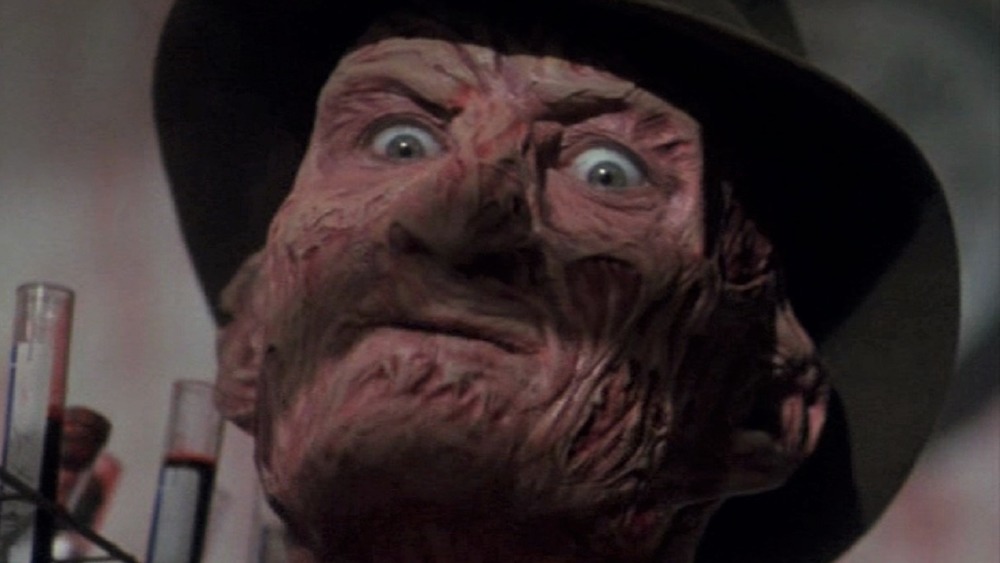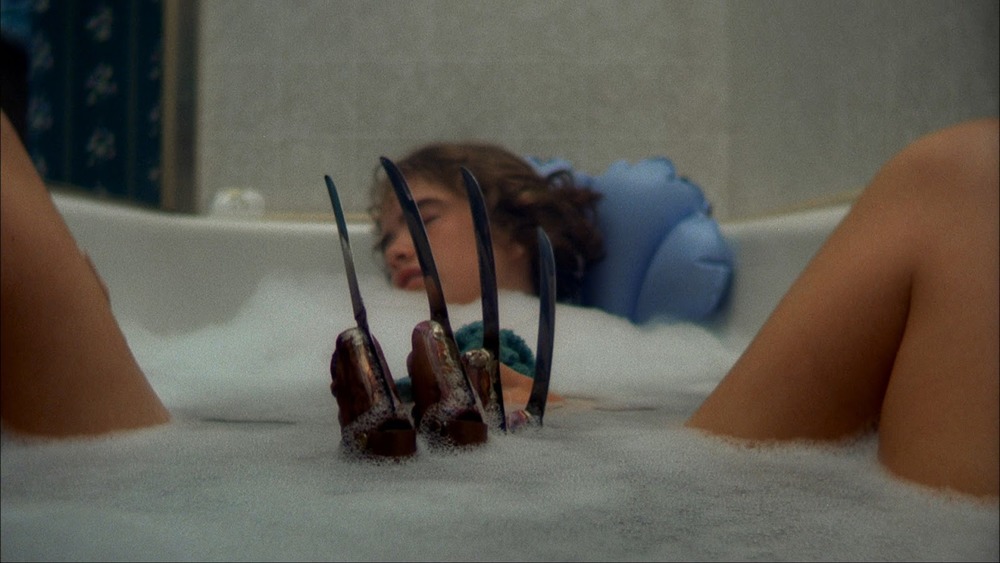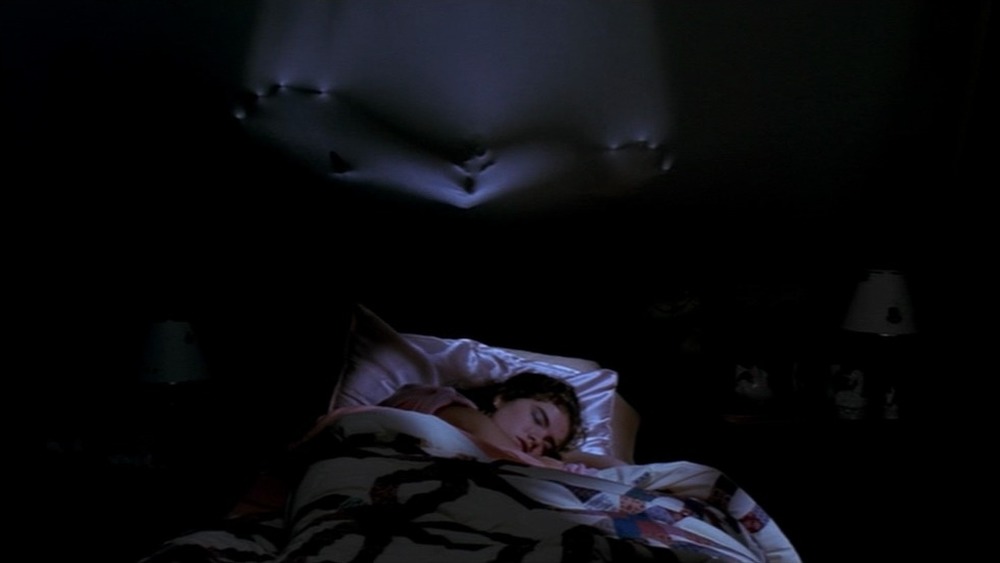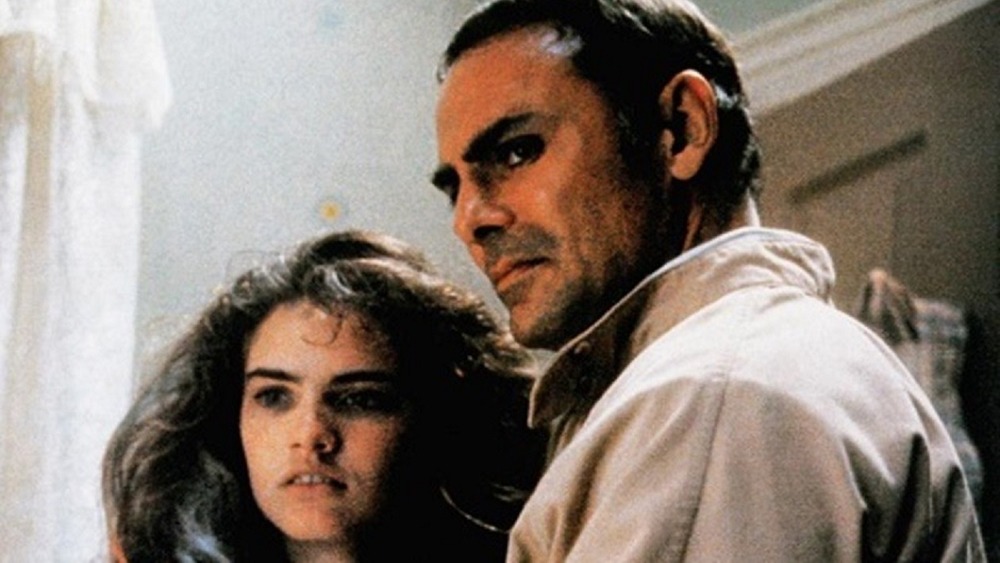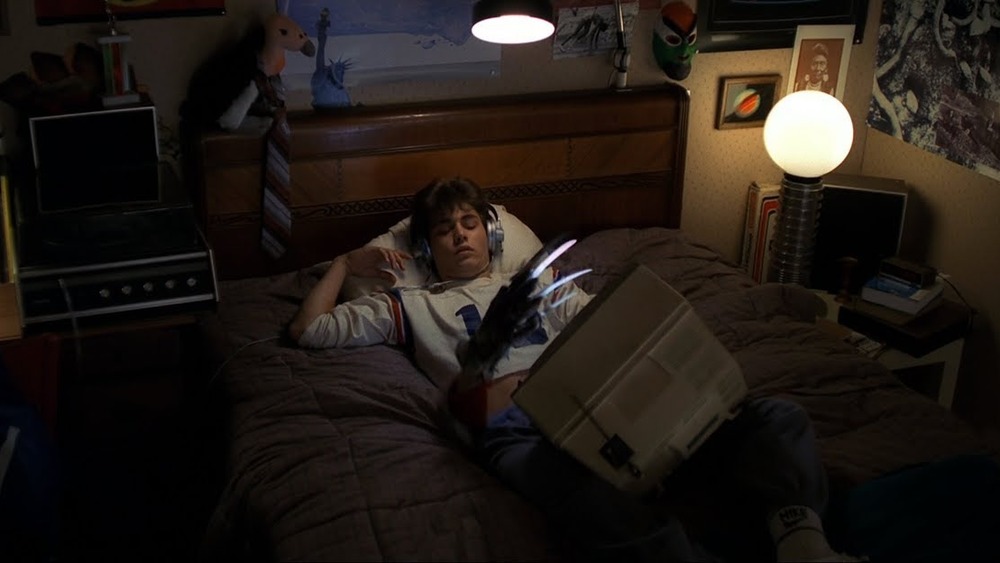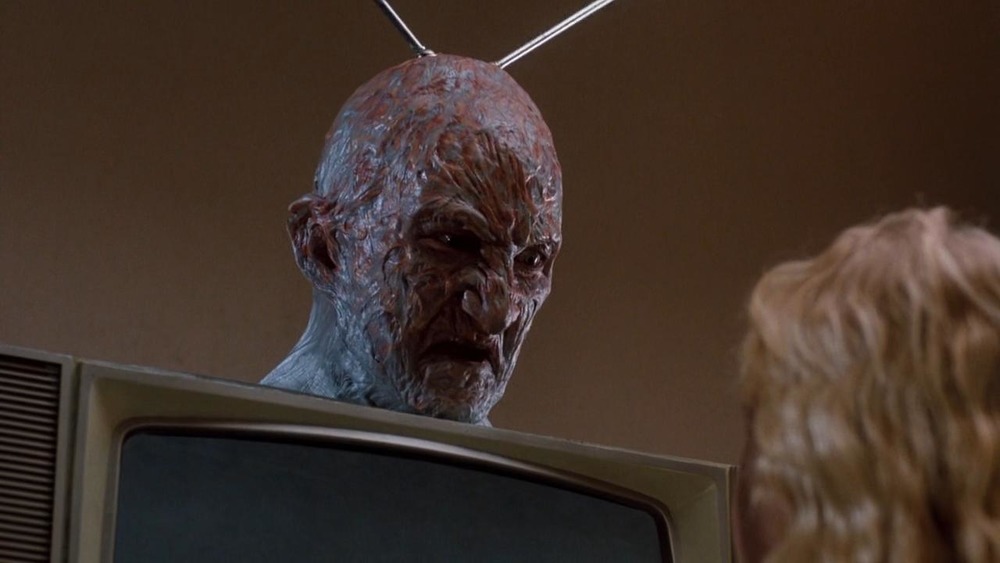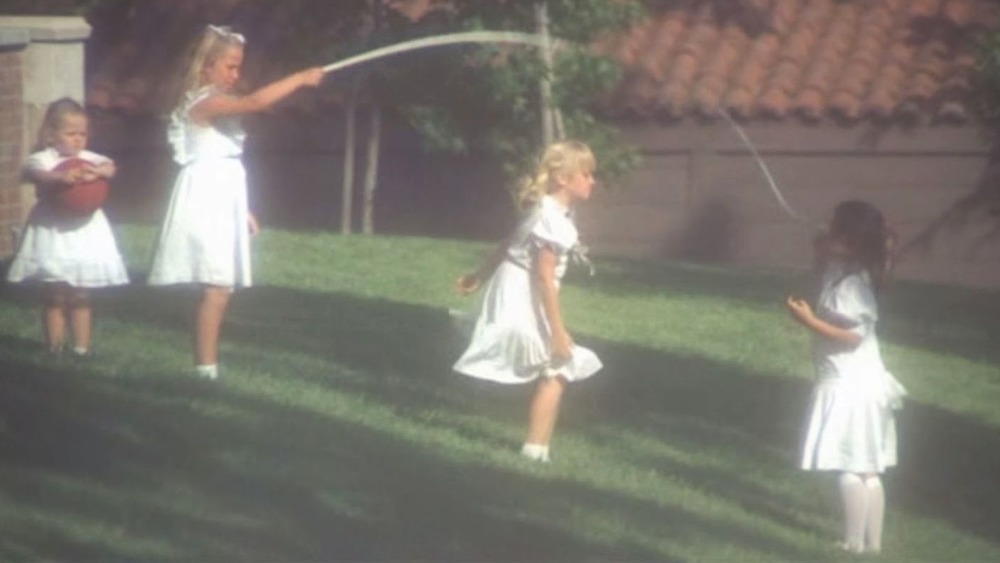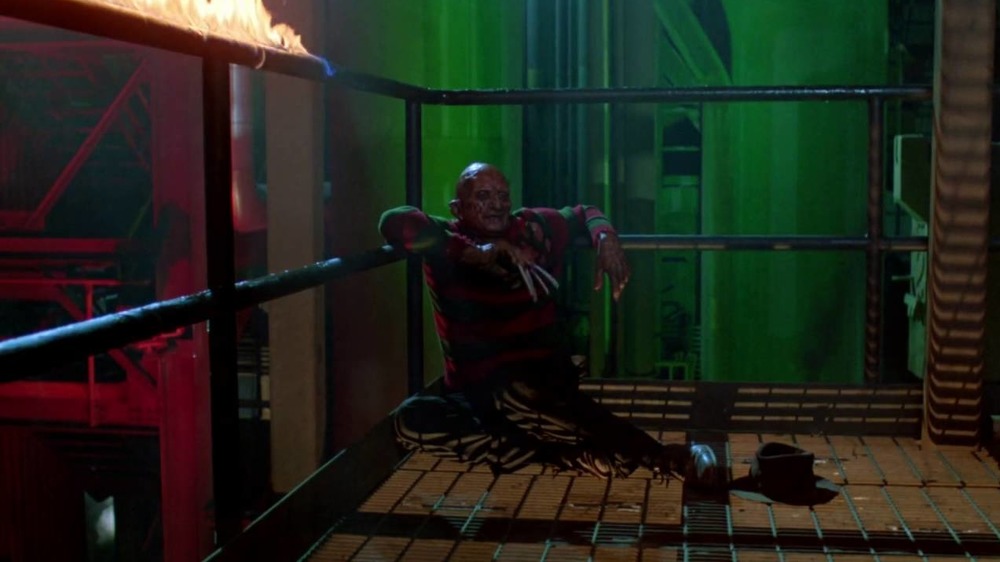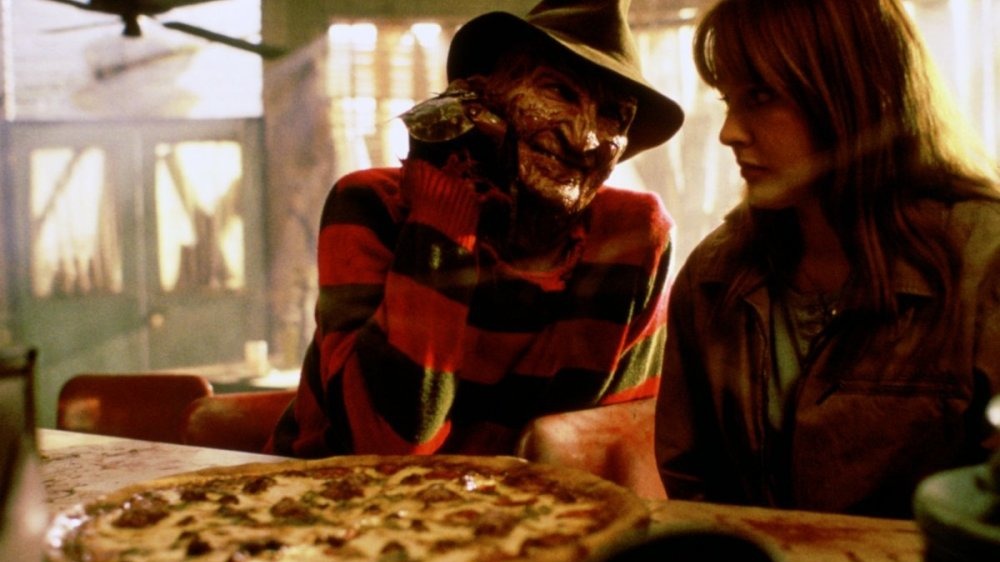Things That Happen In Every Nightmare On Elm Street Movie
With seven proper installments, plus a crossover and a remake, the Nightmare on Elm Street series stands as one of horror's most enduring franchises. In terms of pure household name recognition among psycho movie killers, Freddy Krueger (Robert Englund) sits right up there with Norman Bates and Hannibal Lecter. Sure, there hasn't been an officially produced Nightmare movie in over a decade, so maybe he's not the megastar he used to be. But we bet even nowadays, if you show the average person a leather glove with knives attached at the fingers, complete with that iconic sweater and fedora, they'll think "Krueger."
Freddy's got a lot of cultural capital. But he's also got a consistency problem. And we're not just talking critical reviews here. Over the course of the series, a whole lot has changed about this dream demon and the town of Springwood, Ohio. After all, you've got to keep things fresh in a franchise this big. But never fear, Nightmare fans. Even though each film puts its own unique spin on Krueger and the teens he torments, there will always be certain things that happen in each film. From the basic rules to body horror, here's what happens in every Nightmare on Elm Street movie.
The Final Girl rule always applies in the Nightmare on Elm Street movies
Freddy leaves a trail of destruction wherever he goes, but no matter how many people he slaughters, he can never seem to kill that Final Girl. The main hero of the Nightmare on Elm Street movies always gets away. Even when it looked like he killed Nancy Thompson (Heather Langenkamp) in the original film, she showed up in Dream Warriors very much alive.
Granted, the Final Girl always has a tough time. She barely out-maneuvers Freddy throughout the story while he hacks and slashes her friends to bleeding chunks. And in the end, just when it seems like Freddy is about to add the Final Girl to his score, she pulls the rug out from under our big burned boy, and he's the one who winds up torched in the furnace or ripped apart by the ghosts of his previous victims.
Of course, sometimes the Final Girl in one movie becomes a "regular girl" in a subsequent movie. At that point, all bets are off, and Freddy may very well shuffle her off this mortal coil. And we should also point out that not all Final Girls are actually girls. In Freddy's Revenge, that role falls to Jesse Walsh (Mark Patton), who's technically a Final Boy. Granted, his fate is left rather ambiguous at the end of the film, but we never see him die, and if Nancy survived her bizarro dream ending, we're sure Jesse is probably fine ... more or less.
Everybody's gonna wanna avoid falling asleep
Sometimes, filmmakers change Freddy to better suit their stories. Now and again, they go so far as to build up Freddy's backstory. But all that's fine, as long as his most important element remains intact.
Freddy always attacks his victims in their dreams, in the collective subconscious or astral plane where he wields virtually omnipotent power. His victims occasionally figure out how to pull him into the real world where he's just a vicious burn victim with razor fingers and, therefore, comparatively easy to snuff out. But before it gets to that point, Freddy begins stalking potential human pincushions while they sleep, 100% of the time.
That's why the original film is titled A Nightmare on Elm Street, not A Beautiful Morning on Elm Street, because you can't have a nightmare while you're awake. That's also one of the main reasons why Freddy makes such an unsettling figure. Everyone has to sleep, and if Freddy attacks in dreams where he has complete power, then Freddy can kill anyone at any time, any way he wants to.
Ergo, every Nightmare on Elm Street film contains scenes of characters drinking coffee, munching down caffeine pills, blasting loud music directly into their earholes, and engaging in various other activities designed to avoid or delay sleep. It's ultimately a futile effort — as we mentioned, everyone needs to sleep — but the cannon fodder kids in Nightmare movies all have to try.
The kids are on their own
Nightmare is clearly a horror/fantasy franchise. Almost nothing that occurs in any of these films is remotely plausible in the real world. But, oddly enough, the Freddy movies depict relationships between teenagers and their adult guardians fairly accurately. As anyone who remembers being a teenager knows, whenever teens find themselves trapped in life-or-death battles against demonic forces, they immediately learn that parents, teachers, and professional mental health experts — even a young-ish social worker, like Maggie (Lisa Zane) in Freddy's Dead — are all completely useless.
Making matters worse, grownups typically insist that the kids are simply stressed out and need a nap. These so-called "responsible" people always claim the unholy menace doesn't exist at all, even when they know good and well who Freddy Krueger is. In fact, some of them personally helped burn him alive after that stinking judge let him off on a technicality.
Nancy's dad (John Saxon) provides an exception that proves the rule in Nightmare 3: Dream Warriors, when he tries to come through for the gang at the Westin Hills Psychiatric Center (where the resident doctor plays the part of unhelpful adult). Even then, he was a major skeptic in the first film, and he only decides to be useful after he develops alcoholism due to Freddy killing Nancy's mom. In the real world, if a grownup happens to be chronically depressed and constantly drunk, that grownup will be about as effective against supernatural malevolence as a bag of potatoes.
Freddy kills in creative, unexpected ways
For slasher fans, there's a sadistic glee in witnessing homicidal mayhem that would traumatize us all into a coma if we saw it happen in real life. This is extra true for Nightmare devotees, because while Jason Voorhees and Michael Myers mostly limit their arsenal to machetes and bladed-objects in that spirit, Freddy kills literally any way he feels like killing, even if it defies the laws of physics.
Johnny Depp made his big screen debut as Glen Lantz — Nancy's well-meaning boyfriend — in the original 1984 movie. To send Depp off to stardom with a bang, Freddy pulls Glen into presumable Hell, then shoots his blood back up through his mattress, soaking the bedroom ceiling in a geyser of crimson Glen juice. Why doesn't gravity seem to work on Glen's blood? When an imaginary film character dies under circumstances this awesome, questions like that don't matter.
In latter films, Freddy's homicidal tendencies take a turn for the goofy and gimmicky. There's a character who likes comic books in Nightmare 5: The Dream Child, so Freddy physically sucks him into a comic book and cuts him up while he's two dimensional. There's a character who smokes weed in Freddy's Dead, so Freddy turns into a psychedelic hallucination and kills him that way. Sometimes he takes himself seriously, but other times, Freddy is basically Willy Wonka, except a troupe of Oompa Loompas don't appear to sing a judgmental song after he destroys a young human life.
At least one of Freddy's attempted kills entails a body transformation
One of the most disturbing things about Freddy is how he can morph and manipulate his body whenever he feels like it. And it's a trick he pulls in every single Nightmare on Elm Street film.
For example, Freddy makes his arms grow absurdly long right before he indulges in his first onscreen taste of slaughter. In the second film, he explodes out of a young man's midsection, then heads across the room to stab another hapless teen. But Freddy doesn't get truly hyped about shapeshifting until Nightmare 3: Dream Warriors. He morphs his fingers into syringes to murder a recovering addict, becomes a big ol' worm, and he turns himself into a television set before electrocuting a mentally ill girl to death with his own TV-ized torso.
In subsequent films, Freddy has turned himself into a motorcycle, an invisible ninja, and a gourmet chef. Even in New Nightmare, Freddy puts Gene Simmons to shame with his ever-growing tongue. Stabbing and slashing might be Freddy's go-to choice for a quick and easy notch on his belt. But when it comes time to kill someone in the weirdest manner possible, this slasher never hesitates to change himself into the most ridiculous stuff imaginable.
In the Nightmare on Elm Street movies, someone always recites Freddy's creepy nursery rhyme
One of the creepiest things about Freddy Krueger is that he's got his own theme song. It's a nasty little nursery rhyme ("One, two, Freddy's coming for you"), and it makes an appearance in every film. Most of the time, it's a small group of little kids — well, the abstract idea of little kids manifesting in someone's dream, anyway — singing it to keep time while they skip rope. In Dream Warriors, we hear it between the bursts of static emanating from a malfunctioning TV. In Freddy's Dead, it appears in fragments scrawled across the desolate town of Springwood. But it's always there.
Sometimes, there will be little variations in the lyrics. For example, "five, six, grab your crucifix" is sometimes sung as "grab a crucifix." Occasionally, "seven, eight, can you stay up late?" takes the place of "gonna stay up late." But you get the idea.
Since his methods vary to wild extremes depending on the characteristics of his victim, Freddy doesn't really have a signature catchphrase because no single pun or one-liner would be effective for the majority of his murdering. But the wholesome image of little kids skipping rope serves the same purpose, both on a visual and sonic level. And, as we know from many other films, little kids in horror movies are literally the creepiest things ever. They don't need to do much. In fact, they probably shouldn't. All they've gotta do is walk into a shot, sing a creepy song, and it'll make you pee your pants quicker than a glove full of knives.
Freddy always loses
There aren't a ton of constants that stick throughout Nightmare movies. But if you're a total psycho who genuinely wants to see Freddy Krueger — the ghost of a child murderer, let's remember — come out on top, then the experience of watching these films must make for a profoundly frustrating experience. Why? Because Freddy always loses.
Freddy walks away with his fair share of consolation prizes, no doubt. After his inevitable vanquishing, he might jump out of seemingly nowhere and snatch up someone's mom, he might put his razor hand through a young woman's torso, or he might wink at the camera as Jason Voorhees carries his severed head off-screen. He wins these sneaky, after-the-fact victories that mainly serve to leave the door open for a possible sequel. But that's only after he comes up short in whatever his primary goal happened to be during the particular story.
He can't win because one or more of his prospective victims always manages to outsmart and outmatch him. But if Freddy Krueger's purpose is to kill a handful of people, face defeat, then return in a couple of years when studio executives decide its time for another movie, maybe the concepts of winning and losing don't concern him that much. Maybe Freddy Krueger is just a guy with a job to do, like the rest of us.
Don't expect one Nightmare on Elm Street movie to be exactly like the last one
The slasher subgenre frequently finds itself accused of sameness and redundancy — and rightly so. Plenty of slasher movies are exactly the same. An invincible monster is introduced, and one by one, it cuts down a roster of attractive 20-something actors playing high schoolers. A sole-surviving protagonist vanquishes the adversary and escapes, and then the movie ends.
However, filmmakers started taking risks with Freddy as early as the first sequel. A Nightmare on Elm Street 2: Freddy's Revenge repurposes Robert Englund's signature villain into a metaphor for repressed homosexuality. The third movie, Dream Warriors, takes place in a mental asylum for troubled youths. At one point, Freddy turns into a giant worm version of himself in order to eat a young Patricia Arquette. It's not as bold as Freddy's Revenge, but it's definitely shocking.
The first three Nightmare films are all totally distinct from each other. And the following three movies are all too ridiculous to be predictable. Freddy turns his victims into a supernatural pizza in Nightmare on Elm Street 4: The Dream Master. That's not even scary. It's just bonkers. Things get especially wild with New Nightmare, where director Wes Craven turns the metatextual irony up to 11 by having Krueger be an actual demon that exists outside the Nightmare movies. In other words, Freddy Krueger doesn't repeat himself. His movies might not all be great, but at least he's never boring.
